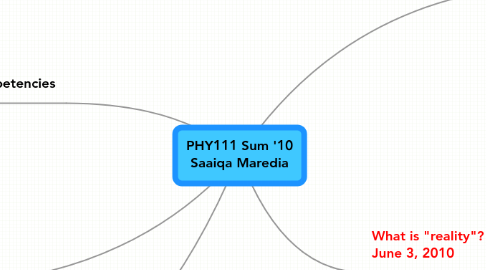
1. Competencies
1.1. Effectively communicate qualitative and quantitative information orally and in writing.
1.1.1. Weekly Glogs
1.2. Explain the application of fundamental physical principles to various physical phenomena.
1.2.1. Lenz's Law and Coil Gun
1.3. Apply appropriate problem-solving techniques to practical and meaningful problems using graphical, mathematical, and written modeling tools.
1.3.1. Projectile Motion activity
1.4. Work effectively in collaborative groups.
1.4.1. Discussing about circuits, emailing back and forth.
1.4.2. Project 1: Discussion with group members.
1.4.3. E-mailing and talking about NOS
2. Explored Electrostatics (concept behind Sticky Tapes and Charges activity) June 7, 2010
2.1. deals with stationary or slow-moving electrical charges
2.2. Coulomb's Law
2.3. Static Electricity
2.3.1. Static electricity is build up of electric charge on an object's surface. Remains charged until neutralized by a discharge.
2.3.2. Objects are formed from atoms and molecules - electrically neutral. Have an equal number or protons and electrons.
2.3.2.1. Separation of positive and negative charges leads to static electricity.
2.3.2.1.1. When a sticky tape is in contact with a smooth surface and then peeled off, there is an uneven distribution of +/- charges. Electrons are transferred from one object to the other, leaving a excess positive or negative charge.
2.3.2.1.2. When a charged sticky-tape is held near a neutral object there is still an attraction between the two. The charged tape causes the charges in a neutral object to separate minutely.
3. Bohr Model
4. Outline
4.1. Linear Motion
4.2. Non-linear Motion
4.2.1. Projectile Motion
4.2.1.1. Projectile Motion Activity
4.2.1.2. A projectile is any object which once projected or dropped continues in motion by its own inertia and is influenced only by the downward force of gravity
4.2.1.3. horizontal motion and the vertical motion are independent of each other and therefore do not affect each other
4.2.1.4. no acceleration in the horizontal direction, but a constant downwards acceleration in vertical direction (due to gravity, 9.81 m/s^2)
4.3. Forces and Momentum
4.3.1. Forces and Fields (Pencast) June 07, 2010
4.3.1.1. Gravitational force
4.4. Work, Energy Storage and Transfer
4.4.1. Energy Storage: Charging of the capacitor in the coil gun.
4.4.2. Electricity
4.4.2.1. "A physical phenomenon associated with stationary or moving electrons and protons" (WordNetWeb).
4.4.2.1.1. 2 types of circuit
4.5. Properties of Matter
4.5.1. Is light a particle or wave? June 4 - June 5, 2010
4.5.1.1. Particle-wave duality
4.5.1.2. Has properties of both particle and wave
4.5.1.2.1. Light can be labeled as wave; bearing units such of wavelength, velocity or frequency. It has the ability to refract, reflect, diffract, etc.
4.5.1.2.2. Light also has energy, which is dependent on its frequency - has momentum - acts as a particle in that sense.
